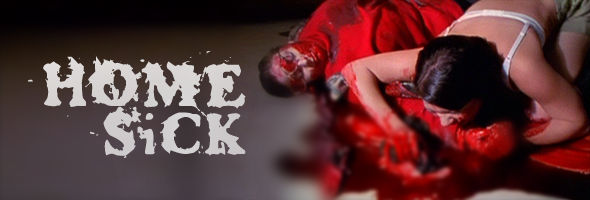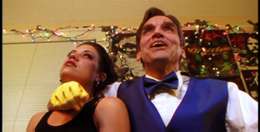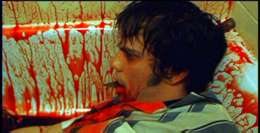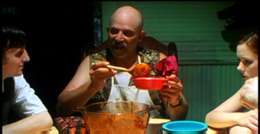

After a puzzling prologue in which a young man winds up filling a bathtub with his blood after a thwarted encounter with a couple of hookers, the film jumps back to the beginning of the story ("earlier that day") as a group of friends in Alabama get together the celebrate the return of one of their friends,
Also featuring a turn from very busy genre vet (and former Troma scream queen) Tiffany Schepis, Home Sick starts off like gangbusters with some rapidly-edited kills and a great, energetic turn from Moseley that shoots the film up with a shot of adrenaline it never quite matches. After his extended
Unlike many first-time projects, Home Sick was shot on film (16mm, in this case) which puts it a visual cut above the usual DV fare. First-time filmmakers Adam Wingard and producer/writer E.L. Katz do a good job of bathing the screen in vivid, eye-catching color schemes (but the lighting wanders oddly astray in a few shots), though the aforementioned lopsided editing works overtime to wring some sort of dramatic flow out of several scenes (not helped by a few less than stellar performances in some supporting roles). Synapse's DVD looks solid and is progressive flagged, though the letterboxed transfer is 4:3 (maybe because editing was finished on video, but that's just a guess; a similar thing happened with Wild Zero). The whole story about the creation of the film (which finished shooting in 2003 but didn't hit screens until 2007, then DVD the following year) is covered in the two main supplements, a Wingard/Katz commentary track and a featurette, "In a Room Where Darkness Counts," which cover the arduous path of the film from its creation (when the director was only 19) to its eventual completion, as well as the means necessary to obtain the three main stars (with only Schepis having a major role, and of course losing her top for good measure). The commentary's excellent, too, and in many respects is more compelling than the feature itself. You also get three of the duo's short films, "The Girlfriend" (the most interesting of the bunch and clocking in at half an hour), "1,000 Year Sleep," and the perplexing "Laura Panic." Finally you get a 5-minute interview with Moseley about his character and a long deleted opening sequence wisely ditched in favor of the final one.
Directed by Adam Wingard / Starring Lindley Evans, Bill Moseley, Tiffany Schepis, Forrest Pitts, Tom Towles, Brandon Carroll
Synapse (US R0 NTSC) / WS (1.85:1) (16:9) / DD2.0
 A film gorged with enough plasma to fuel a dozen Dimension Extreme releases, Home Sick sounds on paper like a horror fan's dream come true. An old-fashioned splatter film with cast members from The Texas Chainsaw Massacre and Henry: Portrait of a Serial Killer? Check. A narrative hook that sets up a hefty body count at the hands of a mystery killer? Check. Ridiculous dialogue? Check. So does the end result live up to expectations? Let's see...
A film gorged with enough plasma to fuel a dozen Dimension Extreme releases, Home Sick sounds on paper like a horror fan's dream come true. An old-fashioned splatter film with cast members from The Texas Chainsaw Massacre and Henry: Portrait of a Serial Killer? Check. A narrative hook that sets up a hefty body count at the hands of a mystery killer? Check. Ridiculous dialogue? Check. So does the end result live up to expectations? Let's see...
 Claire (Evans). All of these twentysomethings are basically abrasive, self-absorbed jackasses, so it's a relief when the tedium is broken with the arrival of a stranger named Mr. Suitcase (Moseley), who uses a suitcase full of razors to slice wounds in himself every time someone answers the question, "Who do you hate?" When the last person jokingly answers that he hates everyone in the room, the suitcase psycho abruptly leaves, and the carnage begins. Realizing they're all on a hit list, the friends opt between arming themselves or going to the cops, with everyone stupidly opting for the former courtesy of one guy's creepy uncle (Towles). Not surprisingly, the plan only leads to an expansion of the chopping list before the spatter-soaked finale.
Claire (Evans). All of these twentysomethings are basically abrasive, self-absorbed jackasses, so it's a relief when the tedium is broken with the arrival of a stranger named Mr. Suitcase (Moseley), who uses a suitcase full of razors to slice wounds in himself every time someone answers the question, "Who do you hate?" When the last person jokingly answers that he hates everyone in the room, the suitcase psycho abruptly leaves, and the carnage begins. Realizing they're all on a hit list, the friends opt between arming themselves or going to the cops, with everyone stupidly opting for the former courtesy of one guy's creepy uncle (Towles). Not surprisingly, the plan only leads to an expansion of the chopping list before the spatter-soaked finale.
 cameo is over, Towles comes in second best with his over-the-top bumpkin routine and makes an impression, but again he's a small supporting player compared to the rest of the cast. All of this points to the problem with the film, which is alluded to in the special features; namely, the whole thing had to be cobbled together into something remotely coherent in the editing room. The final act in particular shows signs of missing footage (or script pages, who knows?) and lingers a long, long time on the gory effects to compensate, which actually works less effectively than the initial gory salvos of the previous scenes. However, if you know this going in and don't expect everything to be tied together with a bow on top at the end, Home Sick delivers its share of sick surprises.
cameo is over, Towles comes in second best with his over-the-top bumpkin routine and makes an impression, but again he's a small supporting player compared to the rest of the cast. All of this points to the problem with the film, which is alluded to in the special features; namely, the whole thing had to be cobbled together into something remotely coherent in the editing room. The final act in particular shows signs of missing footage (or script pages, who knows?) and lingers a long, long time on the gory effects to compensate, which actually works less effectively than the initial gory salvos of the previous scenes. However, if you know this going in and don't expect everything to be tied together with a bow on top at the end, Home Sick delivers its share of sick surprises.